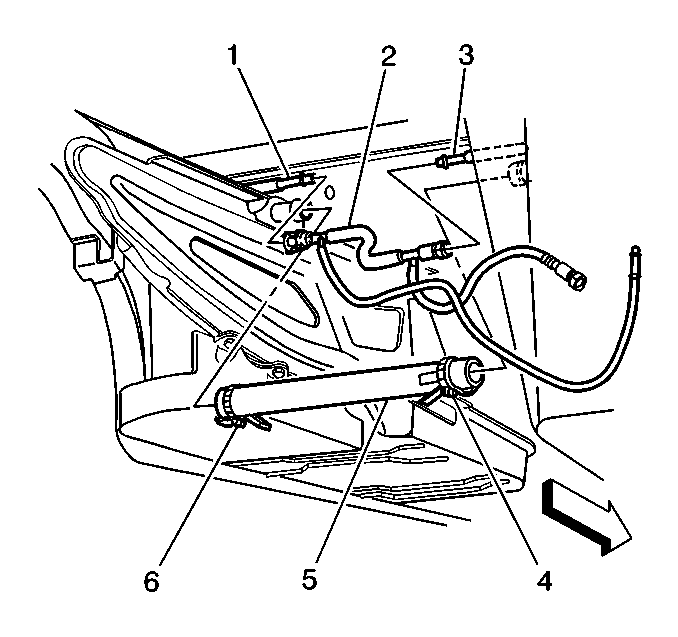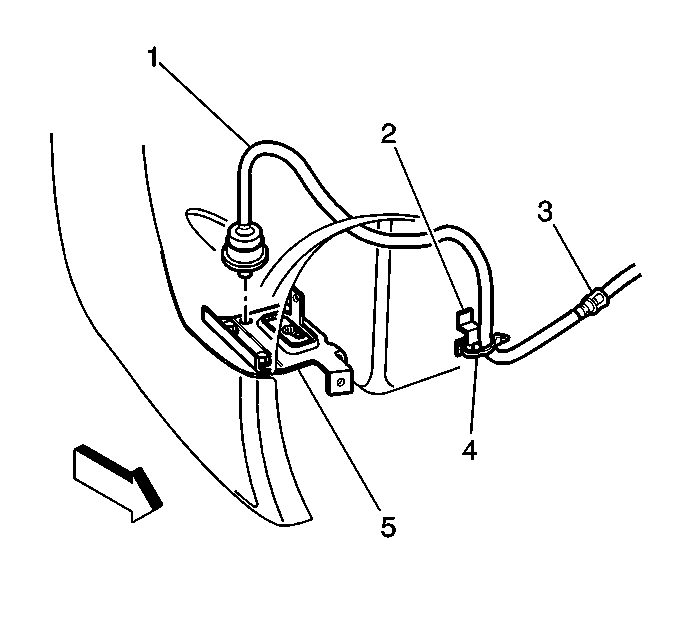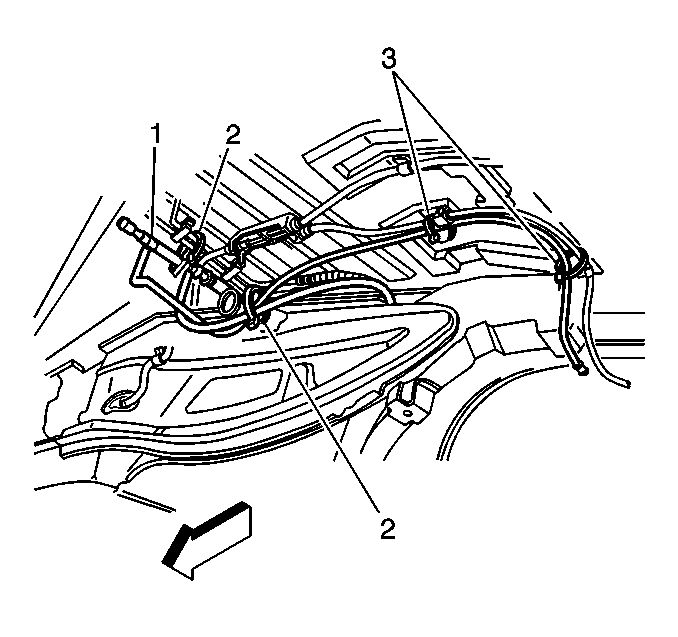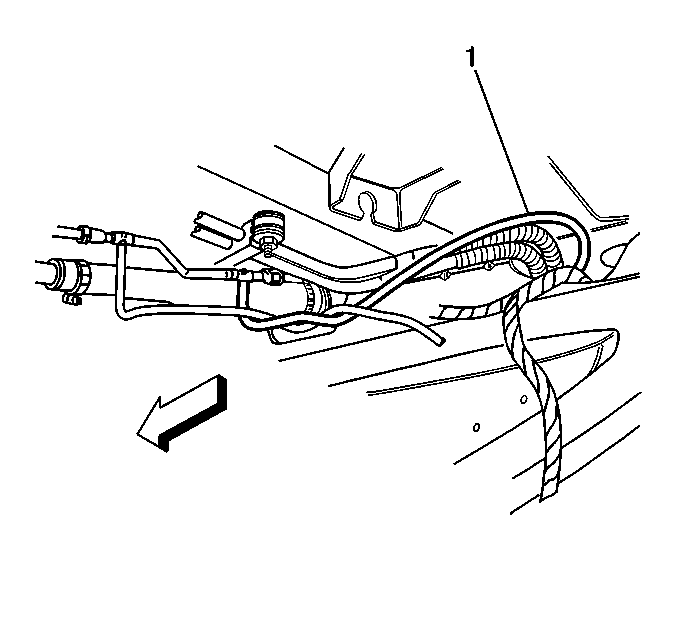Fuel Hose/Pipes Assembly Replacement Rear
Removal Procedure
Tool Required
J 34730-1A Fuel Pressure Gauge
Notice: Replace the EVAP pipes and hoses with the original equipment or parts that meet the GM specifications for those parts. The replacement EVAP pipe must have the same type of fittings as the original pipe in order to ensure the integrity of the connection. When replacing EVAP hoses, use only reinforced fuel-resistant hose identified with the word Fluoroelastomer or GM 6163-M on the hose. The inside hose diameter must match the outside pipe diameter. Do not use rubber hose within 100 mm (4 in) of any part of the exhaust system or within 254 mm (10 in) of the catalytic converter.
Notice:
• Do not repair the fuel feed or return pipes. • Replace the fuel feed and return pipes with original equipment
or with parts that meet the GM specifications for those parts. The replacement
pipe must have the same type of fittings as the original pipe in order to
ensure the integrity of the connection.
Important: Mark or identify each fuel pipe in order to aid in installing the pipes in their original positions.
- Disconnect the negative battery cable.
- Relieve the fuel system pressure. Refer to the Fuel Pressure Relief .
- Drain the fuel tanks. Refer to Fuel Tank Draining .
- Remove the left muffler. Refer to Muffler Replacement in Engine Exhaust.
- Disconnect the tank crossover hose (5) at the left fuel tank.
- Disconnect the fuel tank vapor pipe (2) at the left tank vapor pipe (1).
- Cap the fuel tank vapor pipe in order to prevent possible contamination.
- Disconnect the fuel sender fuel feed pipe (1) (jet pump to left tank). Refer to Plastic Collar Quick Connect Fitting Service .
- Disconnect the fuel return pipe (7) at the fuel filter/pressure regulator. Refer to Plastic Collar Quick Connect Fitting Service .
- Disconnect the fuel feed pipe (8) at the fuel filter/pressure regulator. Refer to Plastic Collar Quick Connect Fitting Service .
- Disconnect the fuel feed rear crossover pipe (2) (left tank to jet pump). Refer to Plastic Collar Quick Connect Fitting Service .
- Disconnect the fuel sender fuel feed pipe (1) at the fuel sender. Refer to Metal Collar Quick Connect Fitting Service or Plastic Collar Quick Connect Fitting Service .
- Disconnect the fuel return rear pipe (2) at the fuel sender. Refer to Metal Collar Quick Connect Fitting Service or Plastic Collar Quick Connect Fitting Service .
- Disconnect the fuel feed rear pipe (3) at the fuel sender. Refer to Metal Collar Quick Connect Fitting Service or Plastic Collar Quick Connect Fitting Service .
- Remove the left side rear fuel pipes.
- Cap the fuel sender pipes.
- Cap the fuel filter/pressure regulator inlet.
- Cap the chassis fuel return pipe.
- Remove the right muffler. Refer to Muffler Replacement in Engine Exhaust.
- Disconnect the crossover hose (5) at the right fuel tank.
- Disconnect the fuel tank vapor pipe (2) at the right tank vapor pipe (3).
- Cap the fuel tank vapor pipe in order to prevent possible contamination.
- Remove the fuel pipes from the two rear upper fuel and EVAP pipe retainers (2).
- Disconnect the fuel sender fuel feed pipe (3) (jet pump to left tank). Refer to Metal Collar Quick Connect Fitting Service or Plastic Collar Quick Connect Fitting Service .
- Disconnect the fuel feed rear crossover pipe (2) (left tank to jet pump). Refer to Metal Collar Quick Connect Fitting Service or Plastic Collar Quick Connect Fitting Service .
- Remove the fuel sender fuel feed pipe (jet pump to left tank).
- Remove the fuel feed rear crossover pipe (left tank to jet pump).
- Cap the fuel sender pipes.
- Disconnect the EVAP purge pipe (1) at the chassis EVAP purge pipe (3). Refer to Plastic Collar Quick Connect Fitting Service .
- Cap the chassis EVAP purge pipe.
- Remove the right fuel tank. Refer to Fuel Tank Replacement .
- Disconnect the fuel tank vapor pipe (2) at the canister. Refer to Plastic Collar Quick Connect Fitting Service .
- Disconnect the EVAP purge pipe (1) at the canister. Refer to Plastic Collar Quick Connect Fitting Service .
- Disconnect the fuel tank vent valve pipe at the quick connect fitting (3).
- Remove the rear fuel tank vapor pipes (1) from the following straps:
- Remove the rear fuel tank vapor pipes.

Caution: Unless directed otherwise, the ignition and start switch must be in the OFF or LOCK position, and all electrical loads must be OFF before servicing any electrical component. Disconnect the negative battery cable to prevent an electrical spark should a tool or equipment come in contact with an exposed electrical terminal. Failure to follow these precautions may result in personal injury and/or damage to the vehicle or its components.









| • | The straps attached to the fuel pipes (2). |
| • | The straps attached to the parking brake cable (3). |
Installation Procedure
- Connect the fuel tank vent valve pipe at the quick connect fitting (3).
- Connect the fuel tank vent valve pipe (1) to the fuel pipes with 2 straps (2).
- Connect the fuel tank vent valve pipe to the parking brake cable with 2 straps (3).
- Route the fuel tank vapor pipe (1) through the right tunnel reinforcement opening.
- Route the EVAP purge pipe through the right tunnel reinforcement opening.
- Connect the fuel tank vapor pipe (2) to the canister. Refer to Plastic Collar Quick Connect Fitting Service .
- Connect the EVAP purge pipe (1) to the canister. Refer to Plastic Collar Quick Connect Fitting Service .
- Install the right fuel tank. Refer to Fuel Tank Replacement .
- Remove the cap from the chassis EVAP purge pipe.
- Connect the EVAP purge pipe (1) to the chassis EVAP purge pipe (3). Refer to Plastic Collar Quick Connect Fitting Service .
- Install the fuel feed rear crossover pipe (2) (left tank to jet pump).
- Install the fuel sender fuel feed pipe (3) (jet pump to left tank).
- Remove the caps from the fuel sender pipes.
- Connect the fuel sender fuel feed pipe (3) (jet pump to left tank). Refer to Metal Collar Quick Connect Fitting Service or Plastic Collar Quick Connect Fitting Service .
- Connect the fuel feed rear crossover pipe (2) (left tank to jet pump). Refer to Metal Collar Quick Connect Fitting Service or Plastic Collar Quick Connect Fitting Service .
- Install the fuel pipes into the two rear upper fuel and EVAP pipe retainers (2).
- Remove the cap from the fuel tank vapor pipe.
- Connect the fuel tank vapor pipe (2) at the right tank vapor pipe (3).
- Connect the tank crossover hose (5) at the right fuel tank.
- Push the clamp (4) outboard against the fuel tank keeping the clamp parallel with the white stripe on the tank crossover hose.
- Install the right muffler. Refer to Muffler Replacement in Engine Exhaust.
- Remove the cap from the chassis fuel return pipe.
- Install and connect the fuel return rear pipe (7) to the fuel filter/pressure regulator. Refer to Plastic Collar Quick Connect Fitting Service .
- Install and connect the fuel feed rear crossover pipe (2) (left tank to jet pump). Refer to Plastic Collar Quick Connect Fitting Service .
- Remove the cap from the fuel filter/pressure regulator inlet.
- Install and connect the fuel feed pipe (8) at the fuel filter/pressure regulator. Refer to Plastic Collar Quick Connect Fitting Service .
- Install and connect the fuel sender fuel feed pipe (1) (jet pump to left tank). Refer to Plastic Collar Quick Connect Fitting Service .
- Remove the caps from the fuel sender pipes.
- Connect the fuel feed rear pipe (3) at the fuel sender. Refer to Metal Collar Quick Connect Fitting Service or Plastic Collar Quick Connect Fitting Service .
- Connect the fuel return rear pipe (2) at the fuel sender. Refer to Metal Collar Quick Connect Fitting Service or Plastic Collar Quick Connect Fitting Service .
- Connect the fuel sender fuel feed pipe (1) at the fuel sender. Refer to Metal Collar Quick Connect Fitting Service or Plastic Collar Quick Connect Fitting Service .
- Remove the cap from the fuel tank vapor pipe.
- Connect the fuel tank vapor pipe (2) at the left tank vapor pipe (1).
- Connect the tank crossover hose (5) at the left fuel tank.
- Push the clamp (6) outboard against the fuel tank keeping the clamp parallel with the white stripe on the tank crossover hose.
- Install the left muffler. Refer to Muffler Replacement in Engine Exhaust.
- Refill the fuel system.
- Tighten the fuel filler cap.
- Connect the negative battery cable.
- Inspect for leaks.
- Program the transmitters. Refer to Transmitter Programming/Synchronization in Keyless Entry.
- Perform the idle learn procedure. Refer to PCM Idle Learn Procedure .






Important: Lubricate the fuel pipes in order to aid in installation. Use mechanic's wire attached to the fuel sender end of the fuel pipe in order to pull the fuel pipe through the tunnel reinforcement opening. Pull the fuel pipe through from the top down.

Notice: Use the correct fastener in the correct location. Replacement fasteners must be the correct part number for that application. Fasteners requiring replacement or fasteners requiring the use of thread locking compound or sealant are identified in the service procedure. Do not use paints, lubricants, or corrosion inhibitors on fasteners or fastener joint surfaces unless specified. These coatings affect fastener torque and joint clamping force and may damage the fastener. Use the correct tightening sequence and specifications when installing fasteners in order to avoid damage to parts and systems.
Tighten
Tighten the fuel and EVAP pipe retainer nuts to 3 N·m (27 lb
in).

Tighten
Tighten the tank crossover hose clamp to 4 N·m (35 lb
in).

Important: Lubricate the fuel pipes in order to aid in installation. Use mechanic's wire attached to the fuel sender end of the fuel pipe in order to pull the fuel pipe through the tunnel reinforcement opening. Pull the fuel pipe through from the top down.


Tighten
Tighten the tank crossover hose clamp to 4 N·m (35 lb
in).
| 40.1. | Turn the ignition switch ON for 2 seconds. |
| 40.2. | Turn the ignition switch OFF for 10 seconds. |
| 40.3. | Turn the ignition switch ON. |
| 40.4. | Check for fuel leaks. |
